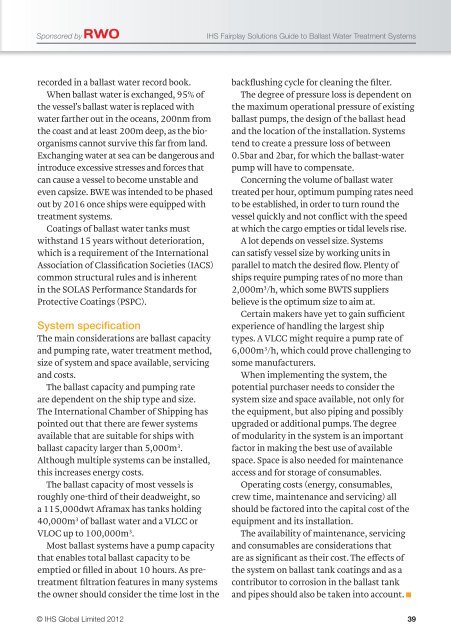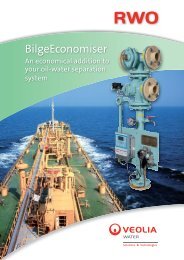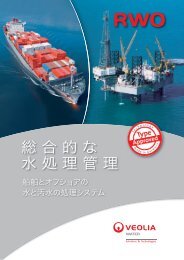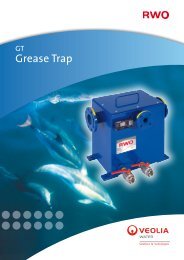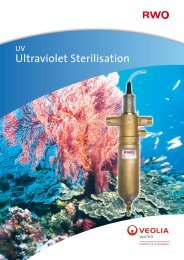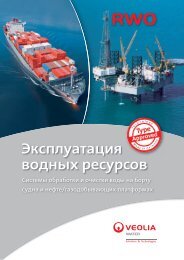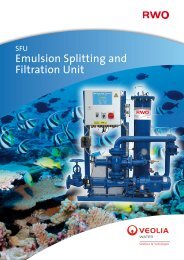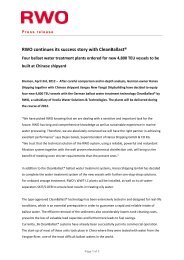the IHS Ballast Water Guide - RWO Marine Water Technology
the IHS Ballast Water Guide - RWO Marine Water Technology
the IHS Ballast Water Guide - RWO Marine Water Technology
Create successful ePaper yourself
Turn your PDF publications into a flip-book with our unique Google optimized e-Paper software.
Sponsored by <strong>IHS</strong> Fairplay Solutions <strong>Guide</strong> to <strong>Ballast</strong> <strong>Water</strong> Treatment Systems<br />
recorded in a ballast water record book.<br />
When ballast water is exchanged, 95% of<br />
<strong>the</strong> vessel’s ballast water is replaced with<br />
water far<strong>the</strong>r out in <strong>the</strong> oceans, 200nm from<br />
<strong>the</strong> coast and at least 200m deep, as <strong>the</strong> bioorganisms<br />
cannot survive this far from land.<br />
Exchanging water at sea can be dangerous and<br />
introduce excessive stresses and forces that<br />
can cause a vessel to become unstable and<br />
even capsize. BWE was intended to be phased<br />
out by 2016 once ships were equipped with<br />
treatment systems.<br />
Coatings of ballast water tanks must<br />
withstand 15 years without deterioration,<br />
which is a requirement of <strong>the</strong> International<br />
Association of Classifi cation Societies (IACS)<br />
common structural rules and is inherent<br />
in <strong>the</strong> SOLAS Performance Standards for<br />
Protective Coatings (PSPC).<br />
System specifi cation<br />
The main considerations are ballast capacity<br />
and pumping rate, water treatment method,<br />
size of system and space available, servicing<br />
and costs.<br />
The ballast capacity and pumping rate<br />
are dependent on <strong>the</strong> ship type and size.<br />
The International Chamber of Shipping has<br />
pointed out that <strong>the</strong>re are fewer systems<br />
available that are suitable for ships with<br />
ballast capacity larger than 5,000m 3 .<br />
Although multiple systems can be installed,<br />
this increases energy costs.<br />
The ballast capacity of most vessels is<br />
roughly one-third of <strong>the</strong>ir deadweight, so<br />
a 115,000dwt Aframax has tanks holding<br />
40,000m 3 of ballast water and a VLCC or<br />
VLOC up to 100,000m 3 .<br />
Most ballast systems have a pump capacity<br />
that enables total ballast capacity to be<br />
emptied or fi lled in about 10 hours. As pretreatment<br />
fi ltration features in many systems<br />
<strong>the</strong> owner should consider <strong>the</strong> time lost in <strong>the</strong><br />
backfl ushing cycle for cleaning <strong>the</strong> fi lter.<br />
The degree of pressure loss is dependent on<br />
<strong>the</strong> maximum operational pressure of existing<br />
ballast pumps, <strong>the</strong> design of <strong>the</strong> ballast head<br />
and <strong>the</strong> location of <strong>the</strong> installation. Systems<br />
tend to create a pressure loss of between<br />
0.5bar and 2bar, for which <strong>the</strong> ballast-water<br />
pump will have to compensate.<br />
Concerning <strong>the</strong> volume of ballast water<br />
treated per hour, optimum pumping rates need<br />
to be established, in order to turn round <strong>the</strong><br />
vessel quickly and not confl ict with <strong>the</strong> speed<br />
at which <strong>the</strong> cargo empties or tidal levels rise.<br />
A lot depends on vessel size. Systems<br />
can satisfy vessel size by working units in<br />
parallel to match <strong>the</strong> desired fl ow. Plenty of<br />
ships require pumping rates of no more than<br />
2,000m 3 /h, which some BWTS suppliers<br />
believe is <strong>the</strong> optimum size to aim at.<br />
Certain makers have yet to gain suffi cient<br />
experience of handling <strong>the</strong> largest ship<br />
types. A VLCC might require a pump rate of<br />
6,000m 3 /h, which could prove challenging to<br />
some manufacturers.<br />
When implementing <strong>the</strong> system, <strong>the</strong><br />
potential purchaser needs to consider <strong>the</strong><br />
system size and space available, not only for<br />
<strong>the</strong> equipment, but also piping and possibly<br />
upgraded or additional pumps. The degree<br />
of modularity in <strong>the</strong> system is an important<br />
factor in making <strong>the</strong> best use of available<br />
space. Space is also needed for maintenance<br />
access and for storage of consumables.<br />
Operating costs (energy, consumables,<br />
crew time, maintenance and servicing) all<br />
should be factored into <strong>the</strong> capital cost of <strong>the</strong><br />
equipment and its installation.<br />
The availability of maintenance, servicing<br />
and consumables are considerations that<br />
are as signifi cant as <strong>the</strong>ir cost. The eff ects of<br />
<strong>the</strong> system on ballast tank coatings and as a<br />
contributor to corrosion in <strong>the</strong> ballast tank<br />
and pipes should also be taken into account.<br />
© <strong>IHS</strong> Global Limited 2012 39<br />
038_039_BW1204.indd 39 21/03/2012 18:45:25


